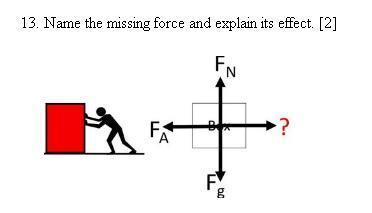Answers
Answer:
friction force
Explanation:
force of friction is opposite to the force applied it resist the motion
Related Questions
A pumpkin is launched in the air and travels at a horizontal velocity of 25 meters per second for 5 seconds. How far does it travel horizontally?
Answers
Answer:
30.3 meters, 172 degrees
Explanation:
To insure the most accurate solution, this problem is best solved using a calculator and trigonometric principles. The first step is to determine the sum of all the horizontal (east-west) displacements and the sum of all the vertical (north-south) displacements.
Horizontal: 2.0 meters, West + 31.0 meters, West + 3.0 meters, East = 30.0 meters, West
Vertical: 12.0 meters, North + 8.0 meters, South = 4.0 meters, North
The series of five displacements is equivalent to two displacements of 30 meters, West and 4 meters, North. The resultant of these two displacements can be found using the Pythagorean theorem (for the magnitude) and the tangent function (for the direction). A non-scaled sketch is useful for visualizing the situation.
Applying the Pythagorean theorem leads to the magnitude of the resultant (R).
R2 = (30.0 m)2 + (4.0 m)2 = 916 m2
R = Sqrt(916 m2)
R = 30.3 meters
The angle theta in the diagram above can be found using the tangent function.
tangent(theta) = opposite/adjacent = (4.0 m) / (30.0 m)
tangent(theta) = 0.1333
theta = invtan(0.1333)
theta = 7.59 degrees
This angle theta is the angle between west and the resultant. Directions of vectors are expressed as the counterclockwise angle of rotation relative to east. So the direction is 7.59 degrees short of 180 degrees. That is, the direction is ~172 degrees.
Calculate the torque produced by a 50.0 N perpendicular force at the end of a 0.300 m long wrench.
Answers
Answer:
Torque = 50N x 0.3m = 15Nm
Explanation:
Torque = Force x length of lever arm. To obtain the torque simply multiply the two given values.
5) You pull a 10.0 kg wagon along a flat road. You exert a force of 80.0 N at an angle of 30.0 degrees above the horizontal while you move the wagon 10.0 m forward. The coefficient of friction between the wagon and road is 0.500. Calculate the work down by you and the work done by friction.
Answers
Consult the attached free body diagram. The only forces doing work on the wagon are the frictional force opposing the wagon's motion and the horizontal component of the applied force.
By Newton's second law, the net vertical force is
• ∑ F [v] = n + (80.0 N) sin(30.0°) - mg = 0
where a is the acceleration of the wagon.
Solve for n (the magnitude of the normal force) :
n = (10.0 kg) g - (80.0 N) sin(30.0°) = 58.0 N
Then
f = 0.500 (58.0 N) = 29.0 N
Meanwhile, the horizontal component of the applied force has magnitude
(80.0 N) cos(30.0°) ≈ 69.3 N
Now calculate the work done by either force.
• friction: -(29.0 N) (10.0 m) = -290. J
• pull: (69.3 N) (10.0 m) = 693 J
HIHIHHHHHHHHIHIHIIHIHHHHIHIHIHIHIHIHIHIHIHIHIHIHIHIIH
Answers
Answer:
Ok thanks for the points though
Explanation:
The force of earth’s gravity is 10N downward. What us the acceleration of a 15kg backpack if lifted with a a 15N force?
Answers
Answer:
F-F(gr) = ma
a= {F-F(gr)}/m =
=(15-10)/15=0.33 m/s² (upward)
